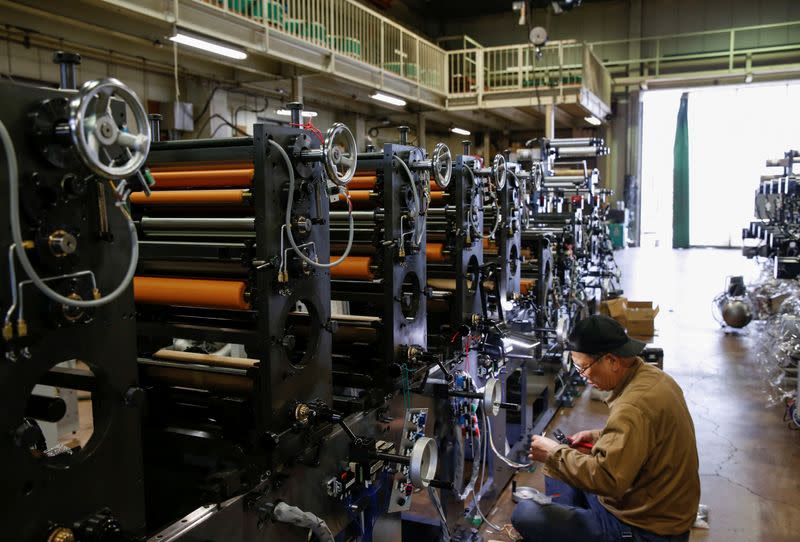Global factory activity mixed in August, signs cost pressures easing

By Lucia Mutikani and Jonathan Cable
WASHINGTON/LONDON (Reuters) -U.S. manufacturing grew steadily in August but factory activity in China, the euro zone and Britain fell as Russia's war in Ukraine and China's zero COVID-19 curbs continued to hurt businesses, surveys showed on Thursday, although there were indications cost pressures were starting to ease.
The overall weakness in global manufacturing activity added to signs sluggish demand in many countries was adding to headaches for companies already suffering from lingering supply constraints.
Major central banks are expected to continue aggressive interest rate hikes in order to tame inflation, which is also dampening optimism through growing fears of a global downturn.
The Institute for Supply Management (ISM) said on Thursday that its index of U.S. factory activity was unchanged at 52.8 last month, although that is still the lowest reading since June 2020, when the sector was pulling out of a COVID-19 induced slump. A reading above 50 indicates expansion in manufacturing, which accounts for 11.9% of the U.S. economy.
But the forward-looking new orders sub-index rebounded to 51.3 last month from a reading of 48.0 in July, ending two straight monthly decreases, and order backlogs rose, suggesting factories in the world's largest economy will continue humming for a while.
U.S. manufacturing is showing resilience despite a shift in spending back to services as well as an ebb in business confidence amid rapidly rising interest rates.
There was also some relief for U.S. factories struggling with surging costs as weakening global demand is having the side-effect of easing price pressures. A measure of input prices paid by manufacturers dropped to 52.5, the lowest reading since June 2020, from 60.0 in July.
Elsewhere, input prices fell in China and Taiwan for the first time since May 2020. South Korean manufacturers saw input prices rise in August by the slowest rate in 19 months, and average input costs faced by Taiwanese goods producers fell for the first time since May 2020.
In the euro zone the input prices index remained well above its long-term average but did fall to its lowest reading since the start of last year.
However, that did little to diminish concerns about slowing global growth.
"We are forecasting a recession in the euro zone and one in the United States next year. Whether that extends into a global recession remains to be seen," said Peter Schaffrik at the Royal Bank of Canada.
MANUFACTURING SHRINKS IN EUROPE, ASIA
Outside the United States, signs of strain deepened. Manufacturing activity across the euro zone shrank for a second month in August, while weak demand meant factories were unable to sell as much as they made and built up stocks of finished goods at a record pace. [EUR/PMIM]
S&P Global's final euro zone manufacturing Purchasing Managers' Index (PMI) dipped to 49.6 in August from July's 49.8, edging further below the 50 mark separating growth from contraction.
In Britain, outside the European Union, factory output and new orders fell by the most in more than two years in the face of deepening uncertainty about surging inflation and the risk of recession at home and abroad. [GB/PMIM]
China's private Caixin manufacturing PMI contracted for the first time in three months in August, as soft demand, power shortages and fresh COVID-19 flare-ups disrupted production.
The unexpectedly weak reading echoed China's official PMI released on Wednesday, which was also below the 50-point mark.
"China's pandemic curbs and geopolitical tensions with the United States continue to disrupt supply chains. Rising inflation is also hurting domestic demand across Asia," said Toru Nishihama, chief economist at Dai-ichi Life Research Institute in Tokyo.
Export powerhouses were also reporting weakness. Japan's factory activity grew at its slowest rate in nearly a year in August, while that of South Korea shrank by the sharpest pace in two years, PMIs for both countries showed.
In Germany, Europe's largest economy and a major exporter, the manufacturing sector contracted for a second month.
Manufacturing activity also deteriorated sharply in Taiwan, with production and new orders both falling at the quickest pace since the initial wave of the pandemic in May 2020.
The final au Jibun Bank Japan Manufacturing PMI fell to 51.5 in August from 52.1 in the prior month, marking the weakest growth rate since September 2021.
South Korea's PMI fell to 47.6 in August from 49.8 in July, remaining below the 50 threshold for a second month and hitting its lowest point since July 2020.
India's factory activity continued to grow robustly in August thanks in part to a boost to output from easing input cost inflation, the country's PMI showed.
Southeast Asia remained a bright spot in the region with manufacturing activity growth in Indonesia, the Philippines and Thailand accelerating, while Malaysia's growth slowed slightly, the PMIs showed.
(Reporting by Lucia Mutikani, Jonathan Cable, Leika Kihara; Writing by Lindsay Dunsmuir; Editing by Sam Holmes, Hugh Lawson and Andrea Ricci)

 Yahoo Finance
Yahoo Finance 